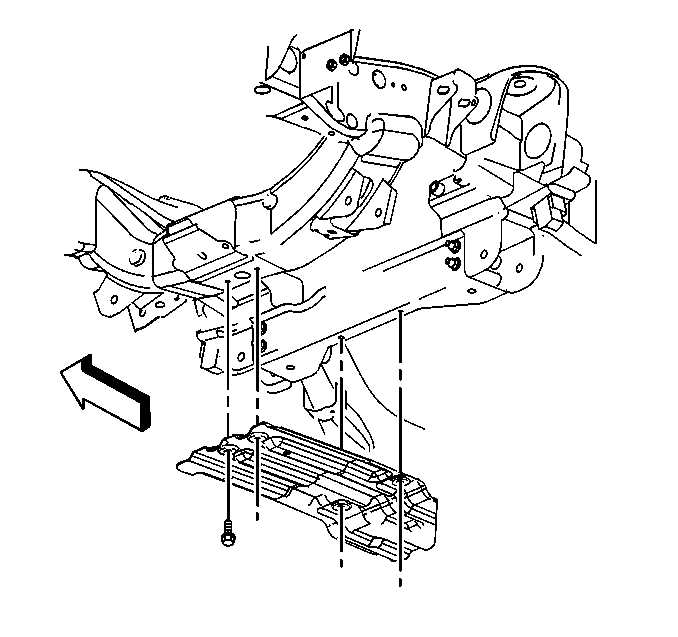
- Disconnect the battery
negative cable. Refer to
Battery Negative Cable Disconnection and Connection
in Engine Electrical.
- Drain the engine coolant. Refer to
Cooling System Draining and Filling
in Engine Cooling.
- Evacuate and recover the A/C refrigerant, if equipped. Refer to
Refrigerant Recovery and Recharging
in Heating,
Ventilation and Air Conditioning.
- Raise the vehicle. Refer to
Lifting and Jacking the Vehicle
in General Information.
- Remove the oil pan skid plate (RWD shown).
- Remove the engine shield, if equipped. Refer to
Engine Protection Shield Replacement
in Frame and Underbody.
- Remove the starter. Refer to
Starter Motor Replacement
in Engine Electrical.

- Remove the transmission
cover.

- Remove the bolt holding
the bracket for the starter cables and transmission cooler lines, if equipped.
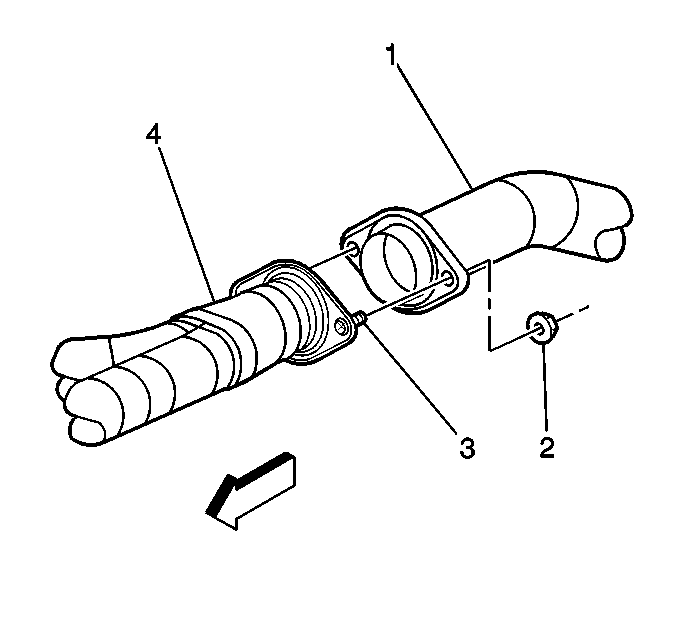
- Loosen the nuts (2)
at the catalytic converter pipe.
- Remove the exhaust pipes from the exhaust manifolds. Refer to
Catalytic Converter Replacement
in Engine Exhaust.

- Remove the bolts holding
the brackets to the oil pan for both battery cables.
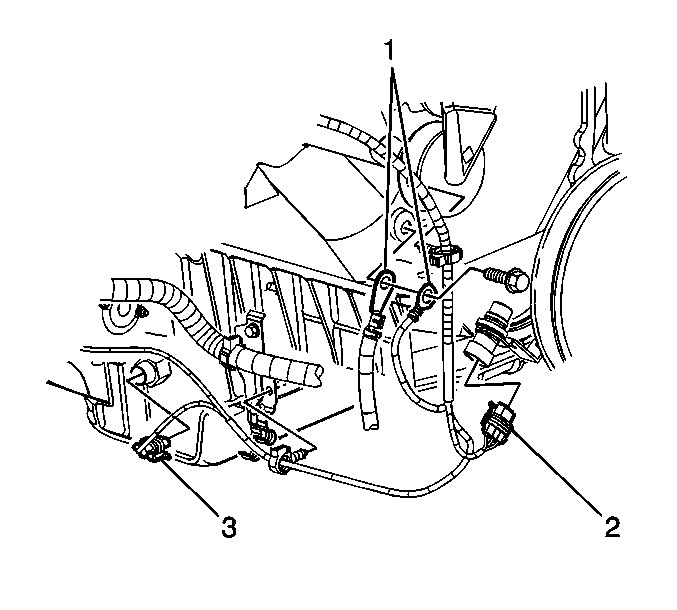
- Disconnect the crankshaft
position (CKP) sensor electrical connector (2) and remove the harness
from the retainer.
- Disconnect the low oil level sensor electrical connector (3)
and remove the wire harness from the retainer.
- Remove the bolt holding the battery negative cable (1)
and a ground cable (1) to the engine.
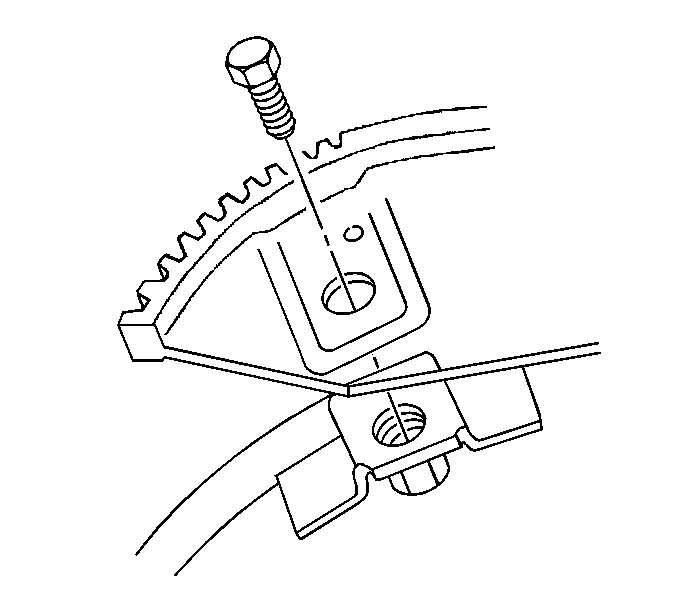
- Remove the torque converter
to flywheel bolts, if equipped, through the starter opening.
- Remove the engine to transmission bolts.
- Lower the vehicle.
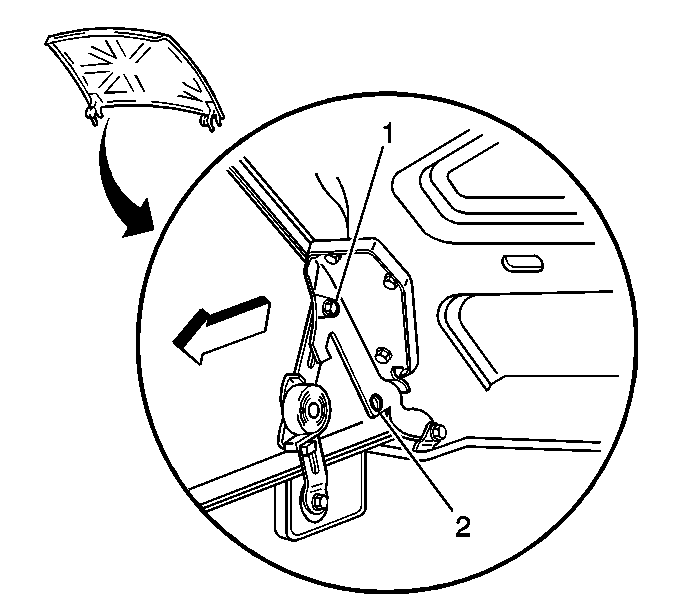
- Move the hood hinge bolts (1)
to hold the hood in the service position (2).
- Disconnect the PCV hose from the air cleaner outlet duct.
- Remove the air cleaner outlet duct from the throttle body and
the air cleaner assembly. Refer to
Air Cleaner Outlet Duct Replacement
in Engine Controls - 4.3L.
- Remove the fan shroud. Refer to
Fan Shroud Replacement
in Engine Cooling.
- Remove the drive belt. Refer to
Drive Belt Replacement
.
- Remove the engine cooling fan. Refer to
Fan Clutch Replacement
in Engine Cooling.
- Remove the radiator inlet hose from the engine. Refer to
Radiator Inlet Hose Replacement
in Engine
Cooling.
- Remove the radiator outlet hose from the engine. Refer to
Radiator Outlet Hose Replacement
in Engine
Cooling.
Caution: In order to avoid possible injury or vehicle damage, always replace
the accelerator control cable with a NEW cable whenever you remove the engine
from the vehicle.
In order to avoid cruise control cable damage, position the cable out
of the way while you remove or install the engine. Do not pry
or lean against the cruise control cable and do not kink the cable. You must
replace a damaged cable.
- Remove the accelerator control cable. Refer to
Accelerator Control Cable Replacement
in Engine Controls.
- Disconnect the cruise control cable from the throttle body and
the bracket on the throttle body and intake manifold, if equipped. Refer to
Cruise Control Cable Replacement
in
Cruise Control.
- Remove the engine wiring harness and clip from the accelerator
control cable bracket.

- Remove the accelerator
control cable bracket from the throttle body.
- Disconnect the A/C hoses from the compressor and the accumulator,
if equipped. Refer to
Compressor Hose Assembly Replacement
in Heating, Ventilation and Air Conditioning.
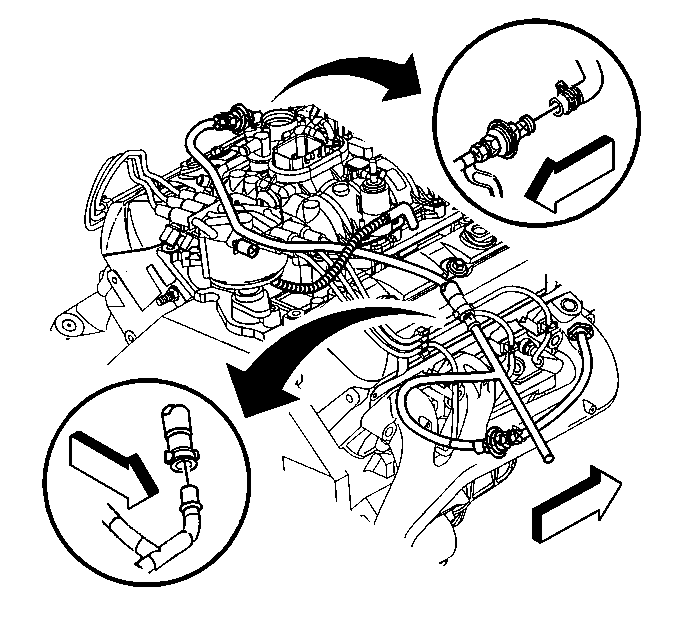
- Remove the secondary air
injection (AIR) crossover pipe from the AIR pipe assemblies.
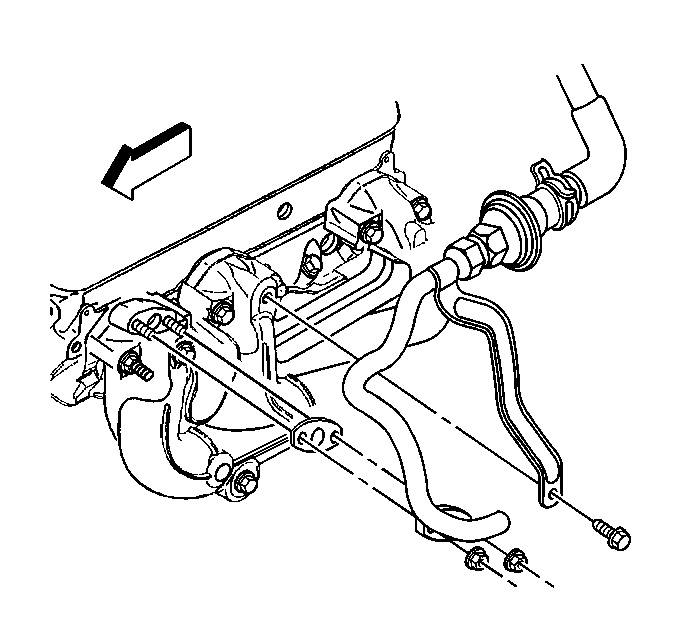
Notice: Remove the AIR pipes before engine removal. The AIR pipes can break
or damage easily causing erratic engine operation.
- Remove AIR pipe assemblies from the left exhaust manifold, if equipped.
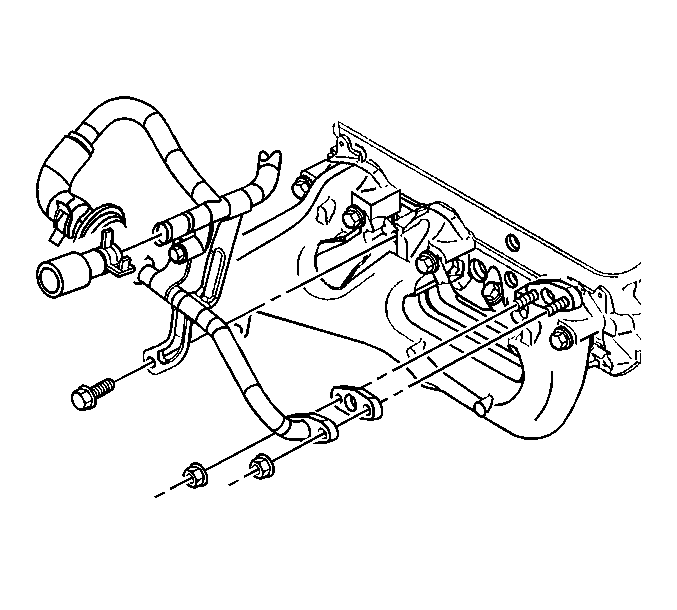
- Disconnect the AIR pipe
assembly from the AIR pump.
- Remove the AIR pipe assembly from the right exhaust manifold,
if equipped.
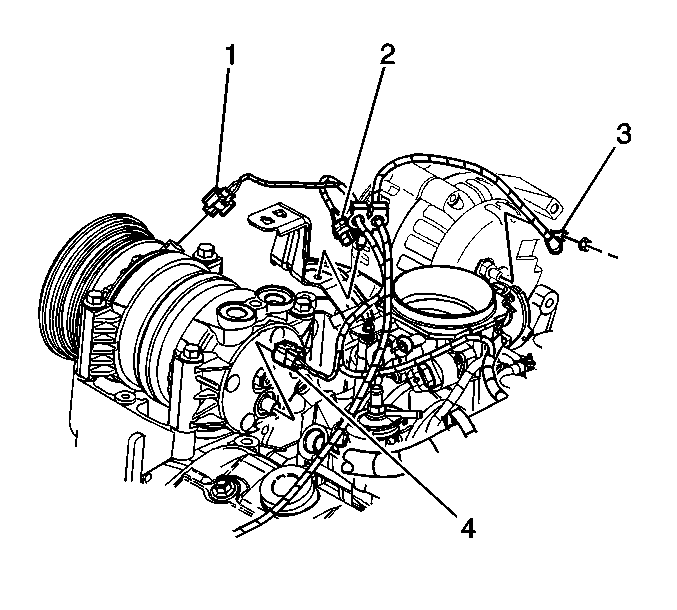
- Disconnect the following
electrical connectors:
| • | The A/C pressure switch (4), if equipped |
| • | The A/C compressor clutch (1), if equipped |
| • | The exhaust gas recirculation (EGR) valve (2) |
| • | The generator battery positive cable (3) |
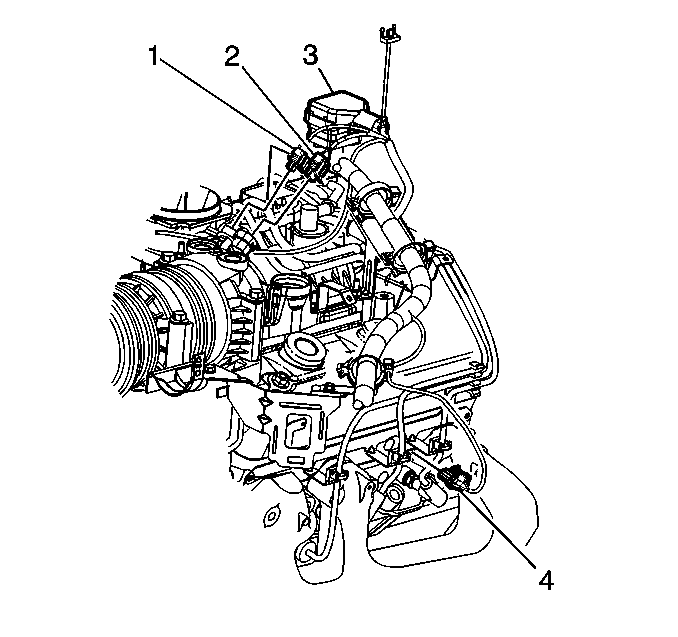
- Disconnect the following
electrical connectors:
| • | The fuel meter body assembly (3) |
| • | The idle air control (IAC) motor (2) |
| • | The throttle position (TP) sensor (1) |
| • | The engine coolant temperature (ECT) sensor (4) |
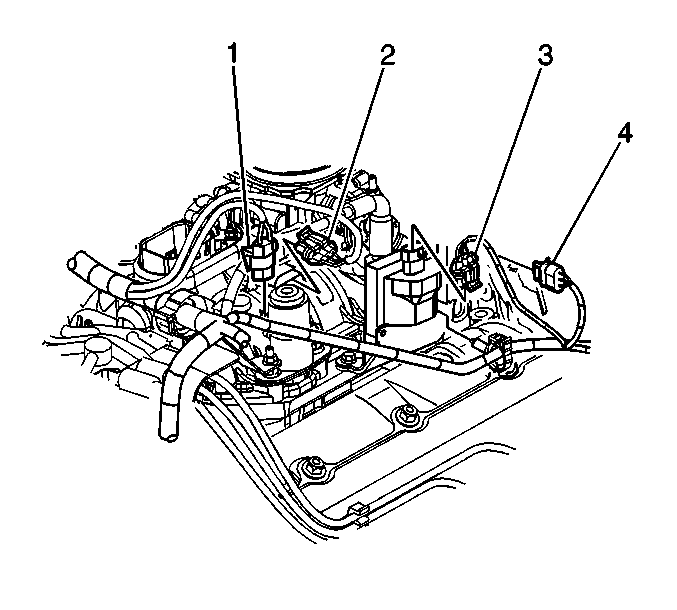
- Disconnect the following
electrical connectors:
| • | The EVAP canister purge solenoid valve (1) |
| • | The manifold absolute pressure (MAP) sensor (2) |
| • | The ignition control module (ICM) (4) |
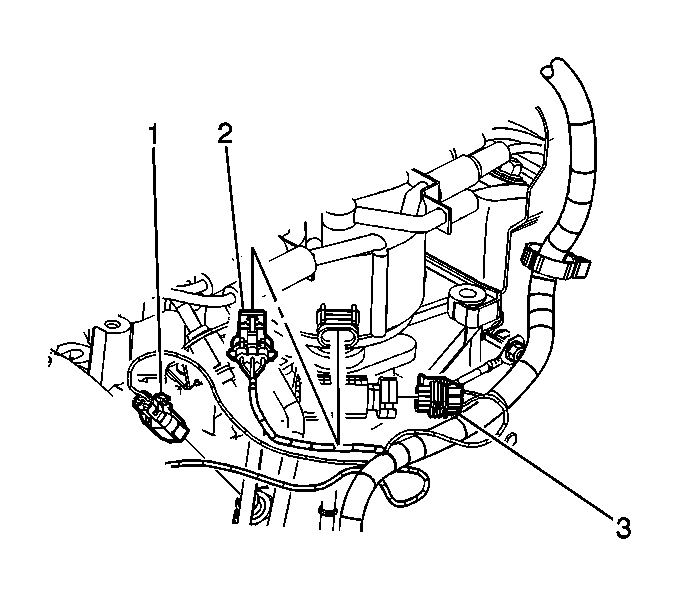
- Disconnect the following
electrical connectors:
| • | The engine oil pressure gauge sensor (3) |
| • | The knock sensor (KS) (1) |
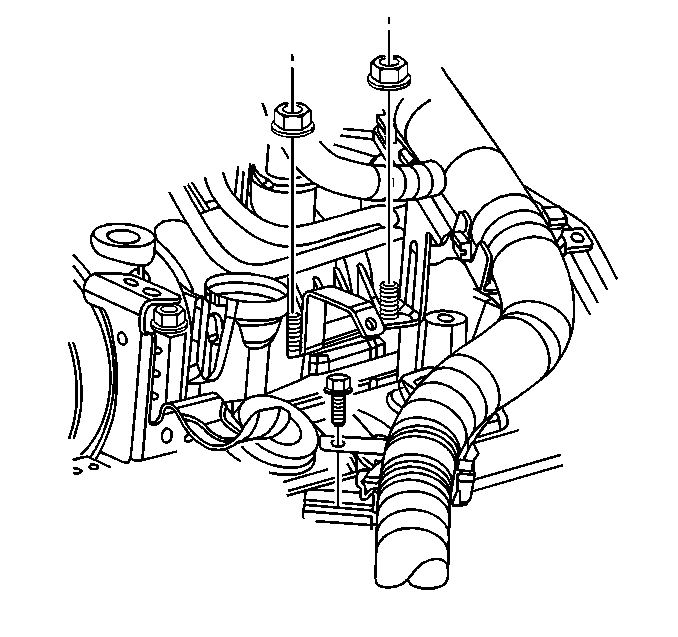
- Remove the nuts holding
the bracket for the engine wiring harness to the intake manifold studs.
- Remove the bolt holding the engine wiring harness clip to the
battery positive cable junction block bracket.
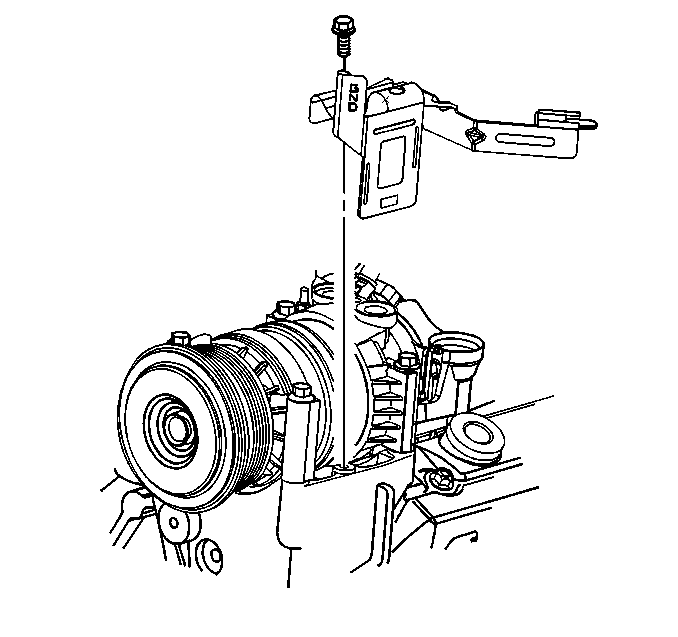
- Remove the bracket for
the battery positive cable junction block from the power steering pump mounting
bracket.

- Move the battery positive
and negative cables aside.
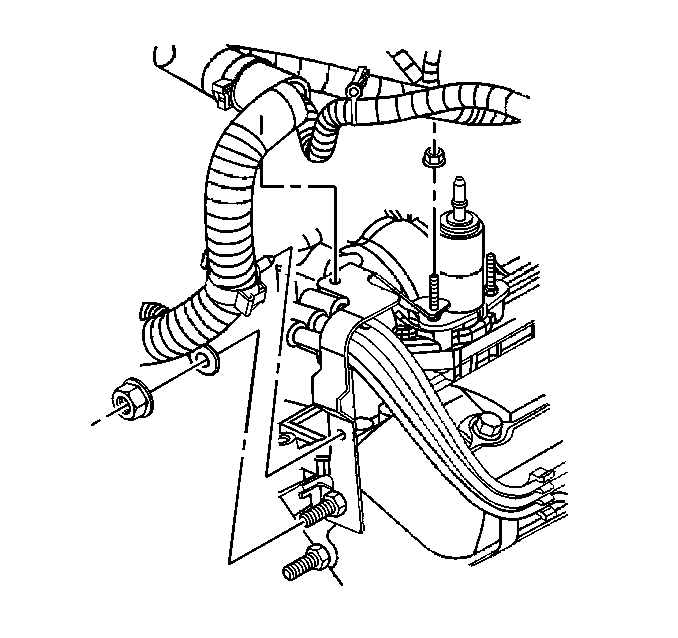
- Remove the nut holding
the ground wire to the stud at the rear of the right cylinder head.
- Remove the stud holding the engine wiring harness bracket to the
rear of the right cylinder head.
- Remove the nut holding the engine wiring harness bracket to the
stud for the EVAP canister purge solenoid valve.
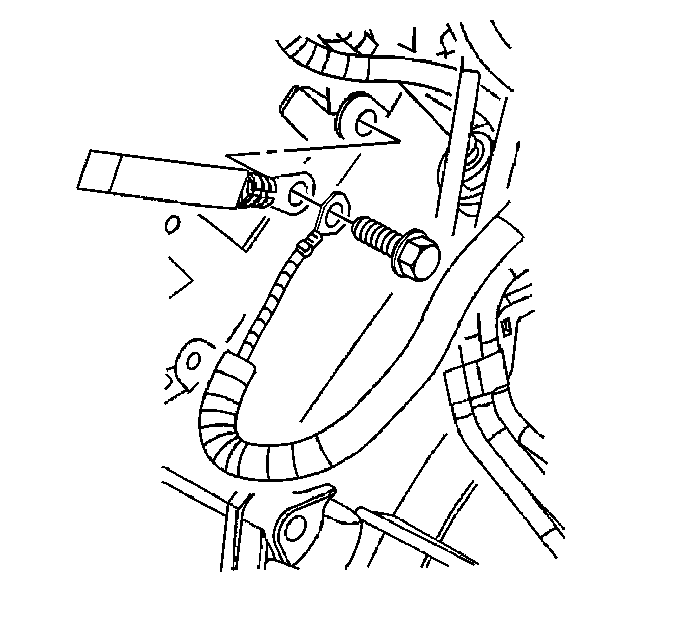
- Remove the bolt holding
the ground strap and the ground wire to the rear of the left cylinder head.
- Move the engine wiring harness aside.
- Remove both heater hoses from the engine and the cowl. Refer to
Heater Hoses Replacement
in Heating, Ventilation
and Air Conditioning.
- Remove the distributor cap. Refer to
Distributor Replacement
in Engine Electrical.
- Disconnect the fuel pipes at the rear of the engine. Refer to
Fuel Hose/Pipes Replacement - Engine Compartment
in Engine Controls - 4.3L.
- Disconnect the hose to the EVAP purge canister solenoid valve.
Refer to
Evaporative Emission Canister Purge Solenoid Valve Replacement
in Engine Controls - 4.3L.

- Disconnect the power brake
booster vacuum hose from the engine and the vacuum brake booster.
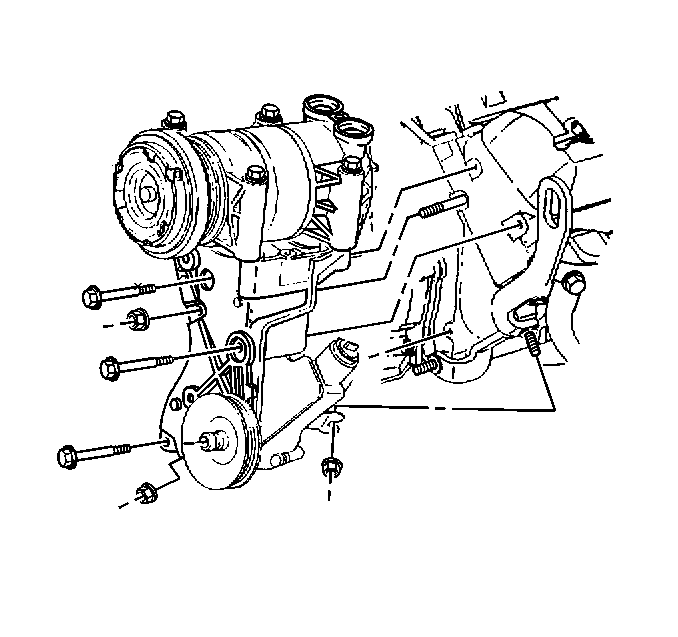
- Loosen the nut holding
the power steering pump rear bracket to the side of the engine.
- Remove the nut holding the power steering pump rear bracket to
the front of the engine.
- Remove the three bolts and the nut holding the power steering
pump mounting bracket to the engine.
- With the power steering pump and the A/C compressor still attach,
slide the power steering pump mount bracket off of the stud and set aside.
- Remove the water outlet. Refer to
Engine Coolant Thermostat Replacement
in Engine Cooling.
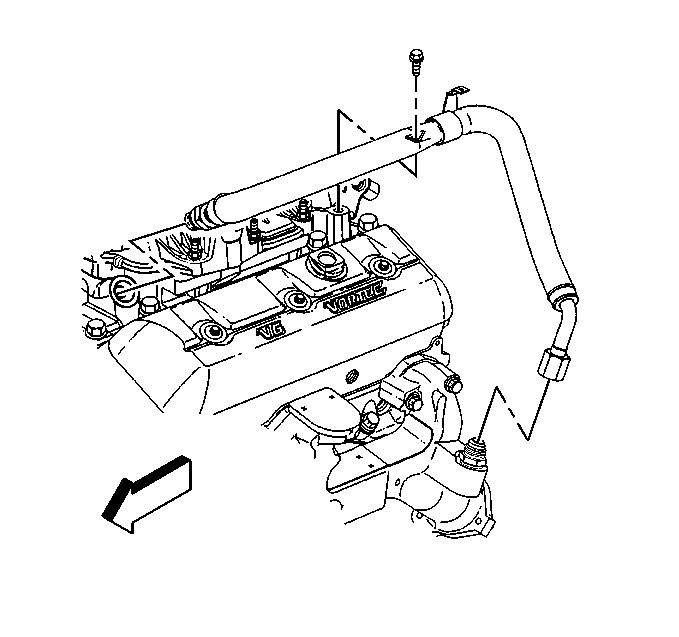
- Remove the EGR valve inlet
pipe from the intake and exhaust manifold.
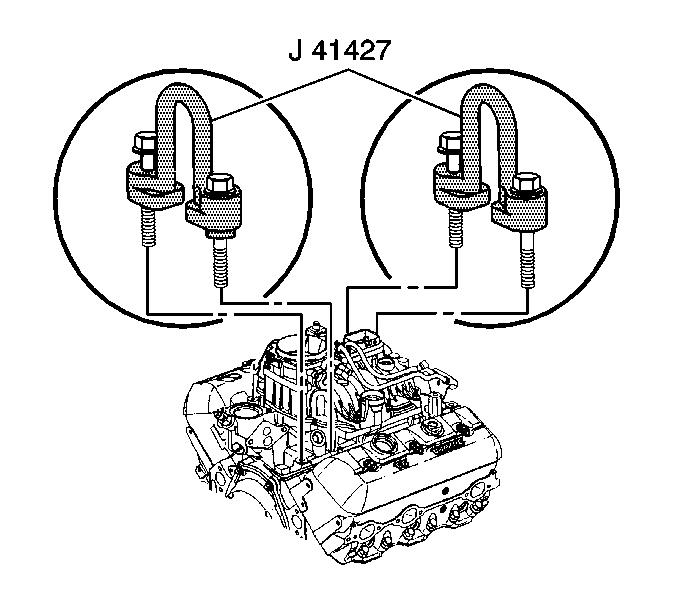
Notice: Use the correct fastener in the correct location. Replacement fasteners
must be the correct part number for that application. Fasteners requiring
replacement or fasteners requiring the use of thread locking compound or sealant
are identified in the service procedure. Do not use paints, lubricants, or
corrosion inhibitors on fasteners or fastener joint surfaces unless specified.
These coatings affect fastener torque and joint clamping force and may damage
the fastener. Use the correct tightening sequence and specifications when
installing fasteners in order to avoid damage to parts and systems.
- Attach the J 41427
to the left front and
right rear intake manifold mounting bolts, using the following procedure:
| 60.1. | Remove the right rear lower intake manifold bolts. |
| 60.2. | Install the J 41427
marked RIGHT REAR. |
| 60.3. | Install the retaining bolts. |
Tighten
Tighten the bolts to 15 N·m (11 lb ft).
| 60.4. | Remove the left front lower intake manifold bolts. |
| 60.5. | Install the J 41427
marked LEFT FRONT with the arrow pointing to the front of the engine. |
| 60.6. | Install the retaining bolts. |
Tighten
Tighten the bolts to 15 N·m (11 lb ft).
- Attach a suitable lifting device to the engine lift brackets.
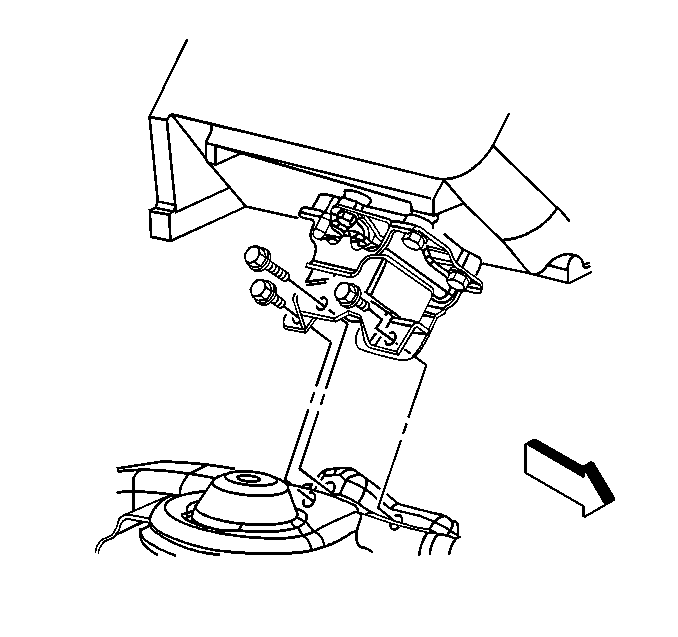
- Remove the engine motor
mount to frame bracket bolts.
- Support the transmission with a suitable jack.
- Remove the engine.

- Install the engine to
the vehicle.
Notice: Use the correct fastener in the correct location. Replacement fasteners
must be the correct part number for that application. Fasteners requiring
replacement or fasteners requiring the use of thread locking compound or sealant
are identified in the service procedure. Do not use paints, lubricants, or
corrosion inhibitors on fasteners or fastener joint surfaces unless specified.
These coatings affect fastener torque and joint clamping force and may damage
the fastener. Use the correct tightening sequence and specifications when
installing fasteners in order to avoid damage to parts and systems.
- Install the engine
mount to frame bracket bolts.
Tighten
Tighten the bolts to 65 N·m (50 lb ft).

- Remove the J 41427
and the lifting device.
- Apply thread lock GM P/N 12345382 or equivalent
to the threads of the lower intake manifold bolts.
- Install the intake manifold bolts.
Tighten
- Tighten the bolts the first pass to 3 N·m (27 lb in).
- Tighten the bolts the second pass to 12 N·m (106 lb in).
- Tighten the bolts the final pass to 15 N·m (11 lb ft).
- Loosely install one transmission to engine bolt.
- Remove the support jack from under the transmission.

- Install the EGR valve
inlet pipe to the intake and the exhaust manifold.
Tighten
- Tighten the EGR valve inlet pipe intake nut to 25 N·m
(18 lb ft).
- Tighten the EGR valve inlet pipe exhaust nut to 30 N·m
(22 lb ft).
- Tighten the EGR valve inlet pipe clamp bolt to 25 N·m
(18 lb ft).
- Install the water outlet. Refer to
Engine Coolant Thermostat Replacement
in Engine Cooling.

- Slide the power steering
pump mounting bracket with the power steering pump and the A/C compressor
on the stud.
- Position the power steering pump rear bracket on the studs.
- Install the power steering pump mounting bracket three bolts and
the nut.
- Install the nut for the power steering pump rear bracket to the
front of the engine.
Tighten
Tighten the power steering pump mounting bracket and the power steering
pump rear bracket bolts and the nuts to 41 N·m (30 lb ft).
- Connect the fuel pipes. Refer to
Fuel Hose/Pipes Replacement - Engine Compartment
in Engine Controls
- 4.3L.
- Connect the hose to the EVAP purge canister solenoid valve. Refer
to
Evaporative Emission Canister Purge Solenoid Valve Replacement
in Engine Controls - 4.3L.

- Connect the vacuum brake
booster hose to engine and the vacuum brake booster.
- Install the distributor cap. Refer to
Distributor Replacement
in Engine Electrical.
- Install both heater hoses to the engine and the cowl. Refer to
Heater Hoses Replacement
in Heating, Ventilation
and Air Conditioning.

- Install the AIR pipe assembly
with new gaskets to the right exhaust manifold, if equipped.
- Install the AIR pipe nuts and bracket bolt.
Tighten
- Tighten the AIR nuts to 25 N·m (18 lb ft).
- Tighten the AIR bracket bolt to 10 N·m (88 lb ft).
- Connect the AIR pipe assembly to the AIR pump.

- Install the AIR pipe assembly
with new gaskets to the left exhaust manifold, if equipped.
- Install the AIR pipe nuts and bracket bolt.
Tighten
- Tighten the AIR nuts to 25 N·m (18 lb ft).
- Tighten the AIR bracket bolt to 10 N·m (88 lb ft).

- Install the AIR crossover
pipe to the AIR pipe assemblies.
- Position the engine wiring harness.

- Connect the following
electrical connectors:
| • | The A/C pressure switch (4), if equipped |
| • | The A/C compressor clutch (1), if equipped |
| • | The exhaust gas recirculation (EGR) valve (2) |
| • | The generator battery positive cable (3) |

- Connect the following
electrical connectors:
| • | The fuel meter body assembly (3) |
| • | The idle air control (IAC) motor (2) |
| • | The throttle position (TP) sensor (1) |
| • | The engine coolant temperature (ECT) sensor (4) |

- Connect the following
electrical connectors:
| • | The EVAP canister purge solenoid valve (1) |
| • | The manifold absolute pressure (MAP) sensor (2) |
| • | The ignition control module (ICM) (4) |

- Connect the following
electrical connectors:
| • | The engine oil pressure gauge sensor (3) |
| • | The knock sensor (KS) (1) |

- Install the bolt holding
the ground strap and the ground wire to the rear of the left cylinder head.
Tighten
Tighten the ground strap and ground wire bolt to 16 N·m
(12 lb ft).

- Position the engine wiring
harness bracket on the EVAP purge canister solenoid valve stud and install
the nut.
- Install the stud holding the wire harness bracket to the rear
of the right cylinder head.
Tighten
| • | Tighten the nut on the EVAP solenoid to 9 N·m (80 lb in). |
| • | Tighten the stud at rear of the cylinder head to 25 N·m
(18 lb ft). |
- Install the nut holding the ground wire on the stud at the rear
of the right cylinder head.
Tighten
Tighten the ground wire nut to 16 N·m (12 lb ft).

- Position the battery positive
and negative cables.
Do not connect the negative battery cable to the battery. Refer to
Battery Cable Replacement
- Install the battery positive cable junction block bracket and
bolt to the power steering pump mounting bracket.
Tighten
Tighten the junction block bracket bolt to 25 N·m (18 lb ft).

- Install the bolt holding
the engine wiring harness bracket to battery positive cable junction block
bracket.
- Install the engine wiring harness bracket on the intake manifold
studs and install the nuts.
Tighten
| • | Tighten the wiring harness bracket nuts to 12 N·m
(106 lb in). |
| • | Tighten the wiring harness bracket bolt to 9 N·m
(80 lb ft). |
- Connect the A/C hoses to the A/C compressor and the accumulator.
Refer to
Compressor Hose Assembly Replacement
in Heating, Ventilation and Air Conditioning.

- Install the accelerator
control cable bracket and nuts to the throttle body.
Tighten
Tighten the nuts to 9 N·m (80 lb in).
- Install the engine wire harness and clip to the accelerator control
cable bracket.
Caution: In order to avoid possible injury or vehicle damage, always replace
the accelerator control cable with a NEW cable whenever you remove the engine
from the vehicle.
In order to avoid cruise control cable damage, position the cable out
of the way while you remove or install the engine. Do not pry
or lean against the cruise control cable and do not kink the cable. You must
replace a damaged cable.
- Install the NEW accelerator control cable. Refer to
Accelerator Control Cable Replacement
in Engine Controls.
- Connect the cruse control cable to the throttle body and the accelerator
control cable bracket, if equipped. Refer to
Cruise Control Cable Replacement
in Cruise Control.
- Install the radiator inlet hose. Refer to
Radiator Inlet Hose Replacement
in Engine Cooling.
- Install the radiator outlet hose. Refer to
Radiator Outlet Hose Replacement
in Engine Cooling.
- Install the engine cooling fan. Refer to
Fan Clutch Replacement
in Engine Cooling.
- Install the drive belt. Refer to
Drive Belt Replacement
.
- Install the upper and lower radiator shroud. Refer
Fan Shroud Replacement
in Engine Cooling.
- Install the air cleaner outlet duct to the throttle body and the
air cleaner assembly. Refer to
Air Cleaner Outlet Duct Replacement
in Engine Controls - 4.3L.
- Connect the PCV hose to the air inlet duct.

- Move the hood hinge bolts
from the service position (2) to the normal operating position (1).
- Raise the vehicle.
- Install the remaining transmission to engine bolts except for
the one where the transmission cover mounts.
- Install the torque convertor to flywheel bolts, if equipped. Refer
to
Flywheel to Torque Converter Bolt Replacement
in Automatic Transmission - 4L60-E.

- Install the transmission
cover and bolts.
Tighten
- Tighten the transmission cover to oil pan bolt to 12 N·m
(106 lb in).
- Tighten the transmission cover to transmission bolt to 47 N·m
(34 lb ft).

- Install the bolt holding
the bracket for the starter cables and the transmission cooler pipes, if
equipped.
Tighten
Tighten the bracket bolt to 9 N·m (80 lb in).

- Install the bolts holding
the positive and negative battery cable brackets to the oil pan.
Tighten
Tighten the bracket bolts to 12 N·m (106 lb in).

- Install the bolt for the
battery negative cable (1) and ground wire (1) to the front
of the engine.
Tighten
Tighten the battery negative cable and ground wire bolt to 25 N·m
(18 lb ft).
- Connect the CKP sensor (2) and install the harness in the
retainer.
- Connect the low oil level sensor (3) and install the wire
harness in the retainer.
- Install the exhaust pipe to the exhaust manifolds and tighten
the nuts at the catalytic converter flange. Refer to
Catalytic Converter Replacement
in Engine Exhaust.
- Install the starter motor. Refer to
Starter Motor Replacement
in Engine Electrical.

- Install the oil pan skid
plate (RWD shown).
Tighten
Tighten the oil pan skid plate bolt to 20 N·m (15 lb ft).
- Install the engine shield. Refer to
Engine Protection Shield Replacement
in Frame and Underbody.
- Lower the vehicle.
- Connect the battery negative cable. Refer to
Battery Negative Cable Disconnection and Connection
in Engine
Electrical.
- Fill the engine with the proper quantity and grade of engine oil.
Refer to
Engine Oil and Oil Filter Replacement
.
- Fill the engine with coolant. Refer to
Cooling System Draining and Filling
in Engine Cooling.
- Recharge the A/C system. Refer to
Refrigerant Recovery and Recharging
in Heating, Ventilation and
Air Conditioning.
- Before starting a new engine, or one that has been repaired. Refer
to
Engine Set-Up and Testing
.

















































